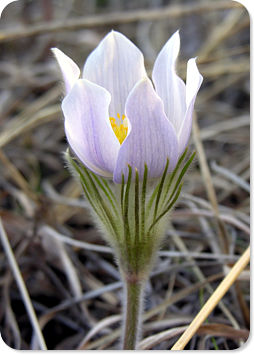 Our prairie crocus.(Published in the Winnipeg Free Press, May 6, 2001) I had to confront a shop keeper the other day. As I wandered through a mall, I chanced upon a sales associate in a flower store misinforming a patron about a plant. She was pointing out that the little purplish flower in a pot, retailing for $3.99, was a crocus, the provincial flower of Manitoba. "Uh . . . excuse me", I butt in, "that flower is indeed a crocus, but it's not our provincial floral emblem. That's a European crocus. Our native prairie crocus is actually a very different plant." The store owner, as it happens, was standing nearby and overheard me. She came over. "Excuse me", she started, "but I acquired these from a local nurseryman, and I know him quite well. He assured me that the crocus is the provincial emblem of Manitoba." "It is", I reiterated, "the prairie crocus (scientific name: Anemone patens) is the provincial floral emblem of Manitoba, but this plant is a European crocus (scientific name: Crocus vernus). It belongs to the same family of plants as irises, the Iridaceae. Our prairie crocus, as it's scientific name implies, is actually an anemone and it belongs in the buttercup family, the Ranunculaceae. They both have small, purplish flowers held close to the ground and they both bloom early in spring, but there the similarity ends." "Oh. . .thank-you for clearing that up for us", she replied, a little icily, I thought. "I'm sorry, but it's a common mistake", I added. "Early settlers discovered a native plant that reminded them of the European crocuses and the name stuck. Unfortunately, it's pretty common for people to confuse the two." Yes, I know its not polite to correct people in public, but I'm sorry, I just can't stand it when people pass on their ignorance of our native flora and fauna. So I espouse "biological correctness" whenever I get a chance. The confusion surrounding our floral emblem is a good case in point, though it was also my fondness for our prairie crocus that stirred me to act. Manitoba's floral emblem is an amazing little plant. We weren't the only ones to think highly of it, it's also the floral emblem of South Dakota. The prairie crocus is, as I mentioned, an anemone, related to buttercups and columbines. It is a low growing, tufted perennial, with finely dissected leaves. It's found in most of our drier tall grass and mixed grass prairies, and even in sandy forested areas. It's most endearing quality is the timing of its blooming. Crocuses are the first wildflowers to emerge in spring, not long after the snow has melted. The opening of its delicate mauve petals is one of the true harbingers of spring. And on the prairies of southern Manitoba, the arrival of spring is a big deal! Spring on the prairies, though, is no guarantee that the cold weather is finished, so how does the crocus deal with the cold? Heard of solar heating? Well, like so many things, nature invented it first. A crocus flower is arranged like a parabolic dish. Its anthers and stamens, the male and female bits, are clustered in the centre of the dish and the outstretched petals act like reflectors to concentrate the suns rays. The temperature in the centre of the flower can be 10 C higher than the surrounding air. When a passing bee arrives, right out of winter's hibernation and hungry for a meal, the crocus can quickly take advantage of the dusting of pollen it receives and get on with making its seeds. Solar heating allows the crocus to bloom so early in spring that it receives the full attention of the emerging pollinators (bees, flies and beetles). It is a gamble though, as late, hard frosts can damage the flowers and result in no seed production that year. With its early start the crocus can be finished ripening its seeds and be storing energy for the next spring's emergence by the time the rest of the prairie plants have grown up to shade it, and before the dryness and heat of summer sets in. It thrives in its spring time niche on the prairies. Its hardiness is an attribute that we prairie-born people like to think we share. Thanks for reading! Got to the: < Previous Column | What's Outdoors Front Page | Next Column >
|
||
|
For more on this topic, here's some articles in NatureNorth.com: |
||
| You can help NatureNorth produce more great articles with a secure donation through PayPal. Our Google Adsense ads pay our server costs, but that's about it. To learn more follow this link: Support NatureNorth. Thank-you! | |
Return to the: NatureNorth.com Front Page
Or pick a seasonal issue to visit:
